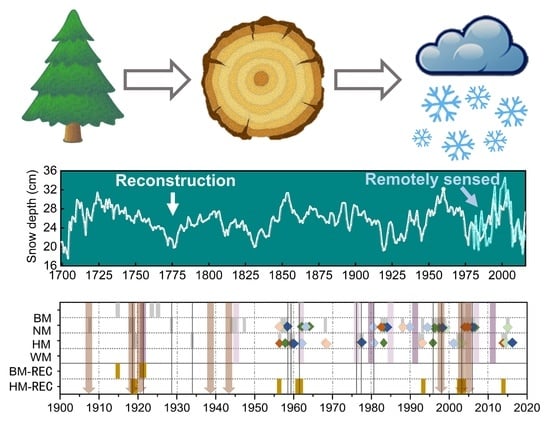Snowpack Dynamics Influence Tree Growth and Signals in Tree Rings of Tianshan Mountain, Central Asia
Abstract
:1. Introduction
2. Materials and Methods
2.1. Study Area and Target Species
2.2. Sample Collection and RWI Chronology Building
2.3. Remotely Sensed Snow Depth Data and Climate Response Analysis Data
3. Results
3.1. Statistical Characteristics of the RWI Chronologies
3.2. Response Analysis of Tree Ring Width to Snow Depth
3.3. Model Statistical Analysis and Snow Depth Reconstruction
4. Discussion
4.1. Historical Data Inspection
4.2. Attribution of the Snow Depth Variations
5. Conclusions
Author Contributions
Funding
Data Availability Statement
Acknowledgments
Conflicts of Interest
References
- Beniston, M.; Farinotti, D.; Stoffel, M.; Andreassen, L.M.; Coppola, E.; Eckert, N.; Fantini, A.; Giacona, F.; Hauck, C.; Huss, M.; et al. The European mountain cryosphere: A review of its current state, trends, and future challenges. Cryosphere 2018, 12, 759–794. [Google Scholar] [CrossRef]
- Farinotti, D.; Longuevergne, L.; Moholdt, G.; Duethmann, D.; Mölg, T.; Bolch, T.; Vorogushyn, S.; Güntner, A. Substantial glacier mass loss in the Tien Shan over the past 50 years. Nat. Geosci. 2015, 8, 716–722. [Google Scholar] [CrossRef]
- Kraaijenbrink, P.D.A.; Stigter, E.E.; Yao, T.; Immerzeel, W.W. Climate change decisive for Asia’s snow meltwater supply. Nat. Clim. Chang. 2021, 11, 591–597. [Google Scholar] [CrossRef]
- Yao, T.; Xue, Y.; Chen, D.; Chen, F.; Thompson, L.; Cui, P.; Koike, T.; Lau, W.K.-M.; Lettenmaier, D.; Mosbrugger, V.; et al. Recent Third Pole’s Rapid Warming Accompanies Cryospheric Melt and Water Cycle Intensification and Interactions between Monsoon and Environment: Multidisciplinary Approach with Observations, Modeling, and Analysis. Bull. Am. Meteorol. Soc. 2019, 100, 423–444. [Google Scholar] [CrossRef]
- Natali, S.M.; Watts, J.D.; Rogers, B.M.; Potter, S.; Ludwig, S.M.; Selbmann, A.K.; Sullivan, P.F.; Abbott, B.W.; Arndt, K.A.; Birch, L.; et al. Large loss of CO2 in winter observed across the northern permafrost region. Nat. Clim. Chang. 2019, 9, 852–857. [Google Scholar] [CrossRef] [PubMed]
- Pulliainen, J.; Aurela, M.; Laurila, T.; Aalto, T.; Takala, M.; Salminen, M.; Kulmala, M.; Barr, A.; Heimann, M.; Lindroth, A.; et al. Early snowmelt significantly enhances boreal springtime carbon uptake. Proc. Natl. Acad. Sci. USA 2017, 114, 11081–11086. [Google Scholar] [CrossRef]
- Hu, Z.; Dietz, A.; Zhao, A.; Uereyen, S.; Zhang, H.; Wang, M.; Mederer, P.; Kuenzer, C. Snow Moving to Higher Elevations: Analyzing Three Decades of Snowline Dynamics in the Alps. Geophys. Res. Lett. 2020, 47, e2019GL085742. [Google Scholar] [CrossRef]
- Huning, L.S.; Agha Kouchak, A. Global snow drought hot spots and characteristics. Proc. Natl. Acad. Sci. USA 2020, 117, 19753–19759. [Google Scholar] [CrossRef]
- Mortimer, C.; Mudryk, L.; Derksen, C.; Luojus, K.; Brown, R.; Kelly, R.; Tedesco, M. Evaluation of long-term Northern Hemisphere snow water equivalent products. Cryosphere 2020, 14, 1579–1594. [Google Scholar] [CrossRef]
- Pulliainen, J.; Luojus, K.; Derksen, C.; Mudryk, L.; Lemmetyinen, J.; Salminen, M.; Ikonen, J.; Takala, M.; Cohen, J.; Smolander, T.; et al. Patterns and trends of Northern Hemisphere snow mass from 1980 to 2018. Nature 2020, 581, 294–298. [Google Scholar] [CrossRef]
- Notarnicola, C. Observing Snow Cover and Water Resource Changes in the High Mountain Asia Region in Comparison with Global Mountain Trends over 2000–2018. Remote Sens. 2020, 12, 3913. [Google Scholar] [CrossRef]
- Gao, Y.; Lu, N.; Dai, Y.; Yao, T. Reversal in snow mass trends on the Tibetan Plateau and their climatic causes. J. Hydrol. 2023, 620, 129438. [Google Scholar] [CrossRef]
- Li, Q.; Yang, T.; Zhou, H.; Li, L. Patterns in snow depth maximum and snow cover days during 1961–2015 period in the Tianshan Mountains, Central Asia. Atmos. Res. 2019, 228, 14–22. [Google Scholar] [CrossRef]
- Yang, T.; Li, Q.; Ahmad, S.; Zhou, H.; Li, L. Changes in Snow Phenology from 1979 to 2016 over the Tianshan Mountains, Central Asia. Remote Sens. 2019, 11, 499. [Google Scholar] [CrossRef]
- Mudryk, L.; Santolaria-Otín, M.; Krinner, G.; Ménégoz, M.; Derksen, C.; Brutel-Vuilmet, C.; Brady, M.; Essery, R. Historical Northern Hemisphere snow cover trends and projected changes in the CMIP6 multi-model ensemble. Cryosphere 2020, 14, 2495–2514. [Google Scholar] [CrossRef]
- Kouki, K.; Räisänen, P.; Luojus, K.; Luomaranta, A.; Riihelä, A. Evaluation of Northern Hemisphere snow water equivalent in CMIP6 models during 1982–2014. Cryosphere 2022, 16, 1007–1030. [Google Scholar] [CrossRef]
- Zhang, H.; Zhang, F.; Zhang, G.; Yan, W. Why Do CMIP6 Models Fail to Simulate Snow Depth in Terms of Temporal Change and High Mountain Snow of China Skillfully? Geophys. Res. Lett. 2022, 49, e2022GL098888. [Google Scholar] [CrossRef]
- Li, Q.; Yang, T.; Zhang, F.; Qi, Z.; Li, L. Snow depth reconstruction over last century: Trend and distribution in the Tianshan Mountains, China. Glob. Planet. Chang. 2019, 173, 73–82. [Google Scholar] [CrossRef]
- Zhang, R.; Ermenbaev, B.; Zhang, T.; Ali, M.; Qin, L.; Satylkanov, R. The Radial Growth of Schrenk Spruce (Picea schrenkiana Fisch. et Mey.) Records the Hydroclimatic Changes in the Chu River Basin over the Past 175 Years. Forests 2019, 10, 223. [Google Scholar] [CrossRef]
- Fritts, H.C. Dendrochronology and Dendroclimatology. In Tree Rings and Climate; Academic Press: Cambridge, MA, USA, 1976; Chapter 1. [Google Scholar]
- Coulthard, B.L.; Anchukaitis, K.J.; Pederson, G.T.; Cook, E.; Littell, J.; Smith, D.J. Snowpack signals in North American tree rings. Environ. Res. Lett. 2021, 16, 034037. [Google Scholar] [CrossRef]
- Dolanc, C.R.; Westfall, R.D.; Safford, H.D.; Thorne, J.H.; Schwartz, M.W. Growth–climate relationships for six subalpine tree species in a Mediterranean climate. Can. J. For. Res. 2013, 43, 1114–1126. [Google Scholar] [CrossRef]
- Shamir, E.; Meko, D.; Touchan, R.; Lepley, K.S.; Campbell, R.; Kaliff, R.N.; Georgakakos, K.P. Snowpack- and soil water content-related hydrologic indices and their association with radial growth of conifers in the Sierra Nevada, California. J. Geophys. Res. Biogeosci. 2020, 125, e2019JG005331. [Google Scholar] [CrossRef]
- Sanmiguel-Vallelado, A.; Camarero, J.J.; Gazol, A.; Morán-Tejeda, E.; Sangüesa-Barreda, G.; Alonso-González, E.; Gutiérrez, E.; Alla, A.Q.; Galván, J.D.; López-Moreno, J.I. Detecting snow-related signals in radial growth of Pinus uncinata mountain forests. Dendrochronologia 2019, 57, 125622. [Google Scholar] [CrossRef]
- Sanmiguel-Vallelado, A.; Camarero, J.J.; Morán-Tejeda, E.; Gazol, A.; Colangelo, M.; Alonso-González, E.; López-Moreno, J.I. Snow dynamics influence tree growth by controlling soil temperature in mountain pine forests. Agric. For. Meteorol. 2021, 296, 108205. [Google Scholar] [CrossRef]
- Falarz, M. Tree-Ring Widths and Snow Cover Depth in High Tauern. In Proceedings of the IOP Conference Series: Earth and Environmental Science; IOP Publishing: Bristol, UK, 2017; Volume 95. [Google Scholar]
- Liu, X.; Zhao, L.; Chen, T.; Shao, X.; Liu, Q.; Hou, S.; Qin, D.; An, W. Combined tree-ring width and δ13C to reconstruct snowpack depth: A pilot study in the Gongga Mountain, west China. Theor. Appl. Clim. 2011, 103, 133–144. [Google Scholar] [CrossRef]
- Qin, L.; Yuan, Y.; Zhang, R.; Wei, W.; Yu, S.; Fan, Z.; Chen, F.; Zhang, T.; Shang, H. Tree-Ring Response to Snow Cover and Reconstruction of Century annual Maximum Snow Depth for Northern Tianshan Mountains, China. Geochronometria 2016, 43, 9–17. [Google Scholar] [CrossRef]
- Wei, P.; Zhang, T.; Zhou, X.; Yi, G.; Li, J.; Wang, N.; Wen, B. Reconstruction of Snow Depth Data at Moderate Spatial Resolution (1 km) from Remotely Sensed Snow Data and Multiple Optimized Environmental Factors: A Case Study over the Qinghai-Tibetan Plateau. Remote Sens. 2021, 13, 657. [Google Scholar] [CrossRef]
- Song, Y.; Behrangi, A.; Blanchard-Wrigglesworth, E. Assessment of Satellite and Reanalysis Cold Season Snowfall Estimates Over Arctic Sea Ice. Geophys. Res. Lett. 2020, 47, e2020GL088970. [Google Scholar] [CrossRef]
- Ferrio, J.P.; Díez-Herrero, A.; Tarrés, D.; Ballesteros-Cánovas, J.A.; Aguilera, M.; Bodoque, J.M. Using stable isotopes of oxygen from tree-rings to study the origin of past flood events: First results from the iberian peninsula. Quaternaire 2015, 26, 67–80. [Google Scholar] [CrossRef]
- Panyushkina, I.P.; Meko, D.M.; Macklin, M.G.; Toonen, W.H.J.; Mukhamadiev, N.S.; Konovalov, V.G.; Ashikbaev, N.Z.; Sagitov, A.O. Runoff variations in Lake Balkhash Basin, Central Asia, 1779–2015, inferred from tree rings. Clim. Dyn. 2018, 51, 3161–3177. [Google Scholar] [CrossRef]
- Fan, Y.; Shang, H.; Wu, Y.; Li, Q. Tree-Ring Width and Carbon Isotope Chronologies Track Temperature, Humidity, and Baseflow in the Tianshan Mountains, Central Asia. Forests 2020, 11, 1308. [Google Scholar] [CrossRef]
- Mukhitdinov, A.; Nurtazin, S.; Alimova, S.; Ablaikhanova, N.; Yessimsiitova, Z.; Salmurzauly, R.; Margulan, I.; Mirasbek, Y. The transformation of ecosystems of the ili river delta (kazakhstan) under the flow regulation and climate change. Appl. Ecol. Environ. Res. 2020, 18, 2483–2498. [Google Scholar] [CrossRef]
- Qin, L.; Bolatov, K.; Yuan, Y.; Shang, H.; Yu, S.; Zhang, T.; Bagila, M.; Bolatova, A.; Zhang, R. The Spatially Inhomogeneous Influence of Snow on the Radial Growth of Schrenk Spruce (Picea schrenkiana Fisch. et Mey.) in the Ili-Balkhash Basin, Central Asia. Forests 2022, 13, 44. [Google Scholar] [CrossRef]
- Zhang, R.; Shang, H.; Yu, S.; He, Q.; Yuan, Y.; Bolatov, K.; Mambetov, B.T. Tree-ring-based precipitation reconstruction in southern Kazakhstan, reveals drought variability since A.D. 1770. Int. J. Clim. 2017, 37, 741–750. [Google Scholar] [CrossRef]
- Yuan, Y.; Shao, X.; Wei, W.; Yu, S.; Gong, Y.; Trouet, V. The Potential to Reconstruct Manasi River Streamflow in the Northern Tien Shan Mountains (NW China). Tree-Ring Res. 2007, 63, 81–93. [Google Scholar] [CrossRef]
- Fritts, H.; Swetnam, T. Dendroecology: A Tool for Evaluating Variations in Past and Present Forest Environments. Adv. Ecol. Res. 1989, 19, 111–188. [Google Scholar] [CrossRef]
- Fan, Y.; Shang, H.; Yu, S.; Wu, Y.; Li, Q. Understanding the Representativeness of Tree Rings and Their Carbon Isotopes in Characterizing the Climate Signal of Tajikistan. Forests 2021, 12, 1215. [Google Scholar] [CrossRef]
- Holmes, R. Computer-Assisted Quality Control in Tree-Ring Dating and Measurement. Tree-Ring Bull. 1983, 43, 51–67. [Google Scholar]
- Cook, E.R.; Kairiukstis, L.A. Methods of Dendrochronology: Applications in the Environmental Sciences; Springer: Dordrecht, The Netherlands, 1990; 394p. [Google Scholar]
- Wigley, T.M.L.; Briffa, K.R.; Jones, P.D. On the Average Value of Correlated Time Series with Applications in Dendroclimatology and Hydrometeorology. J. Clim. Appl. Meteorol. 1984, 23, 201–213. [Google Scholar] [CrossRef]
- Yu, J.; Zhou, G.; Liu, Q. Tree-ring based summer temperature regime reconstruction in XiaoXing Anling Mountains, northeastern China since 1772 CE. Palaeogeogr. Palaeoclim. Palaeoecol. 2018, 495, 13–23. [Google Scholar] [CrossRef]
- Jevšenak, J.; Džeroski, S.; Zavadlav, S.; Levanič, T. A Machine Learning Approach to Analyzing the Relationship Between Temperatures and Multi-Proxy Tree-Ring Records. Tree-Ring Res. 2018, 74, 210–224. [Google Scholar] [CrossRef]
- Che, T.; Dai, L.; Zheng, X.; Li, X.; Zhao, K. Estimation of snow depth from passive microwave brightness temperature data in forest regions of northeast China. Remote Sens. Environ. 2016, 183, 334–349. [Google Scholar] [CrossRef]
- Che, T.; Li, X.; Jin, R.; Armstrong, R.; Zhang, T. Snow depth derived from passive microwave remote-sensing data in China. Ann. Glaciol. 2008, 49, 145–154. [Google Scholar] [CrossRef]
- Dai, L.; Che, T.; Ding, Y. Inter-Calibrating SMMR, SSM/I and SSMI/S Data to Improve the Consistency of Snow-Depth Products in China. Remote Sens. 2015, 7, 7212–7230. [Google Scholar] [CrossRef]
- Huang, X.; Deng, J.; Ma, X.; Wang, Y.; Feng, Q.; Hao, X.; Liang, T. Spatiotemporal dynamics of snow cover based on multi-source remote sensing data in China. Cryosphere 2016, 10, 2453–2463. [Google Scholar] [CrossRef]
- Barandiaran, D.; Wang, S.-Y.S.; DeRose, R.J. Gridded Snow Water Equivalent Reconstruction for Utah Using Forest Inventory and Analysis Tree-Ring Data. Water 2017, 9, 403. [Google Scholar] [CrossRef]
- Anderson, S.; Moser, C.L.; Tootle, G.A.; Grissino-Mayer, H.D.; Timilsena, J.; Piechota, T. Snowpack Reconstructions Incorporating Climate in the Upper Green River Basin (Wyoming). Tree-Ring Res. 2012, 68, 105–114. [Google Scholar] [CrossRef]
- Yadav, R.R.; Bhutiyani, M.R. Tree-ring-based snowfall record for cold arid western Himalaya, India since A.D. 1460. J. Geophys. Res. Atmos. 2013, 118, 7516–7522. [Google Scholar] [CrossRef]
- Li, B.; Chen, Y.; Chen, Z.; Xiong, H.; Lian, L. Why does precipitation in northwest China show a significant increasing trend from 1960 to 2010? Atmos. Res. 2016, 167, 275–284. [Google Scholar] [CrossRef]
- Xu, M.; Kang, S.; Wu, H.; Yuan, X. Detection of spatio-temporal variability of air temperature and precipitation based on long-term meteorological station observations over Tianshan Mountains, Central Asia. Atmos. Res. 2018, 203, 141–163. [Google Scholar] [CrossRef]
- Tang, Z.; Wang, X.; Wang, J.; Wang, X.; Li, H.; Jiang, Z. Spatiotemporal Variation of Snow Cover in Tianshan Mountains, Central Asia, Based on Cloud-Free MODIS Fractional Snow Cover Product, 2001–2015. Remote Sens. 2017, 9, 1045. [Google Scholar] [CrossRef]
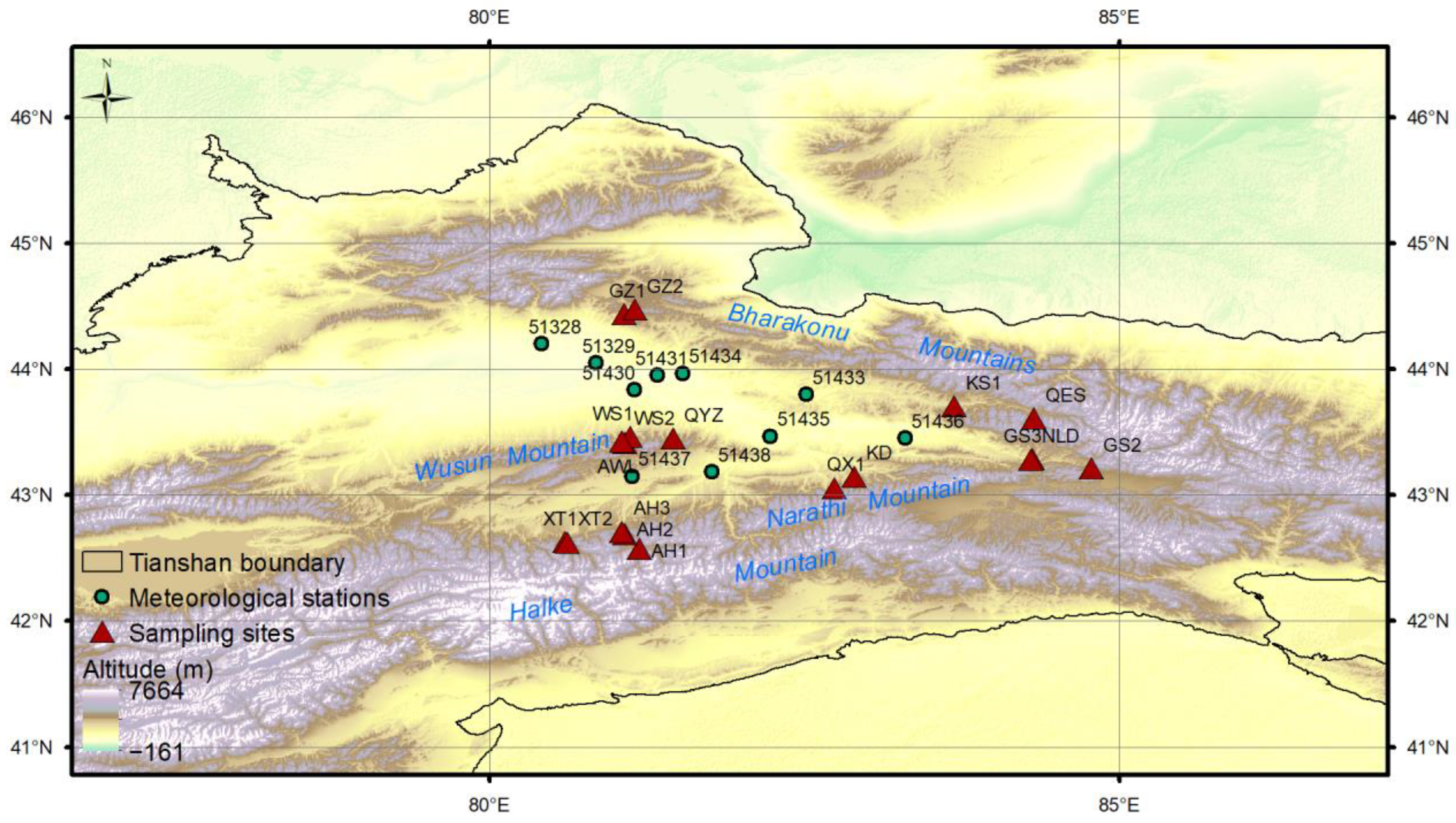
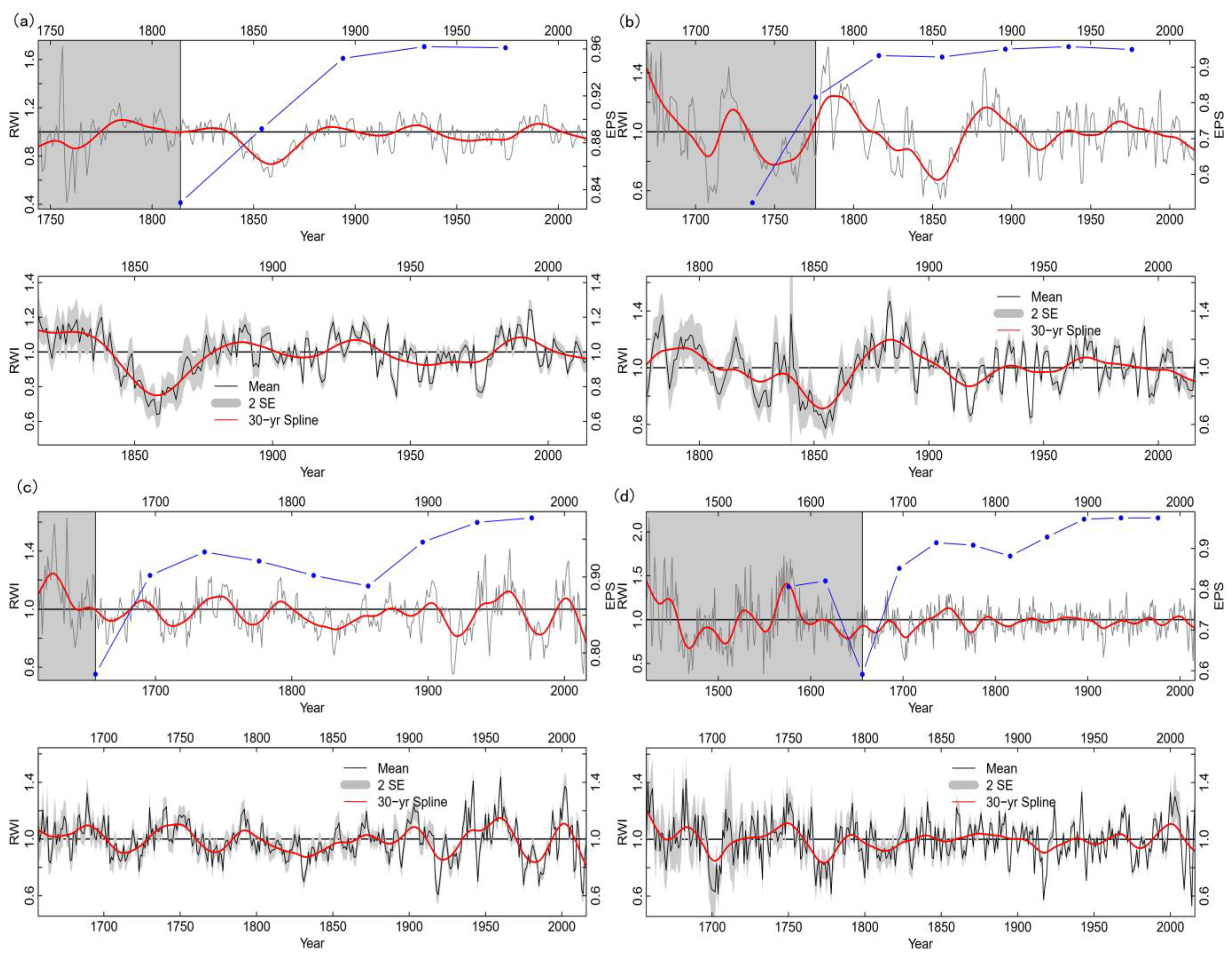
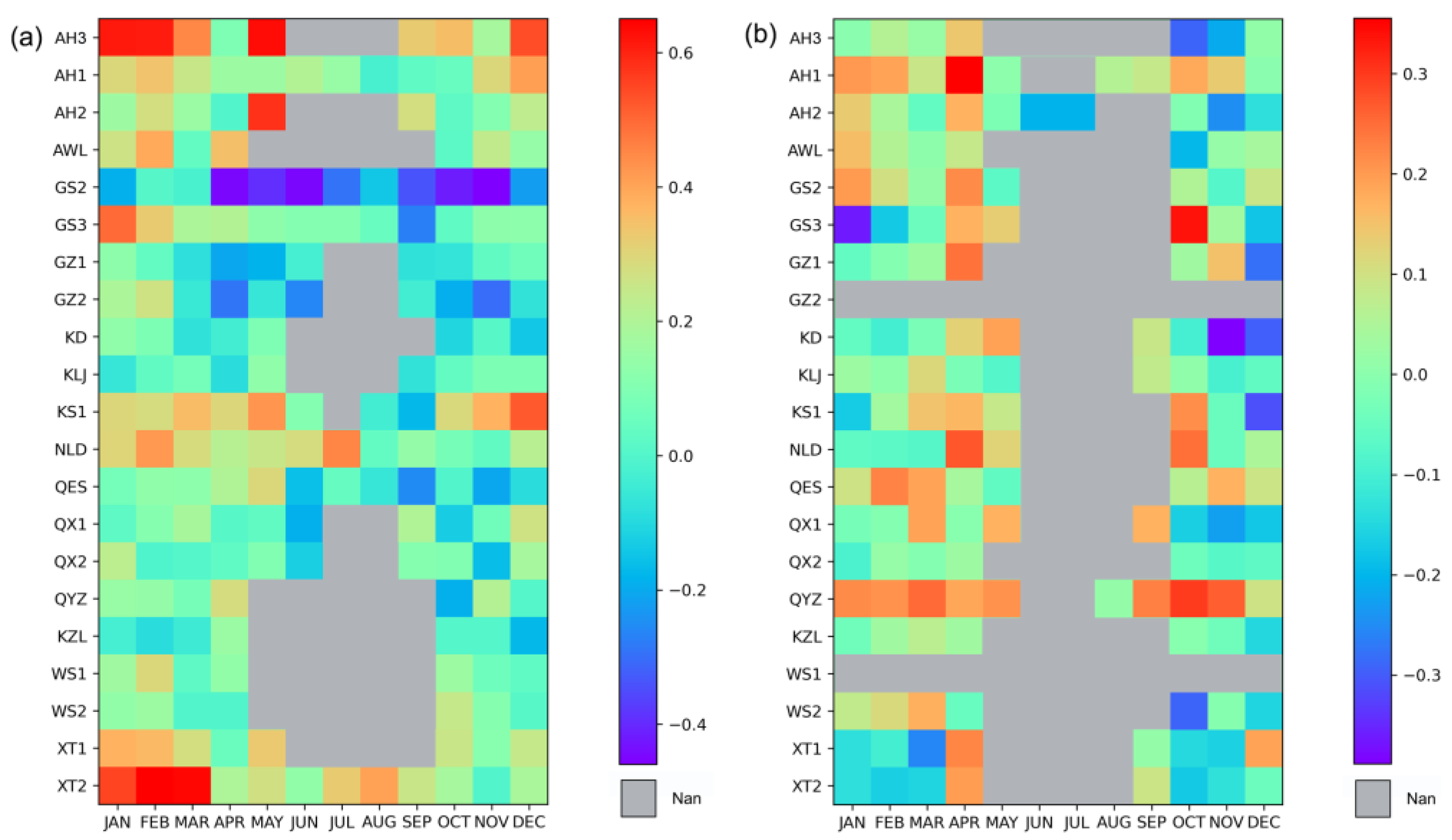

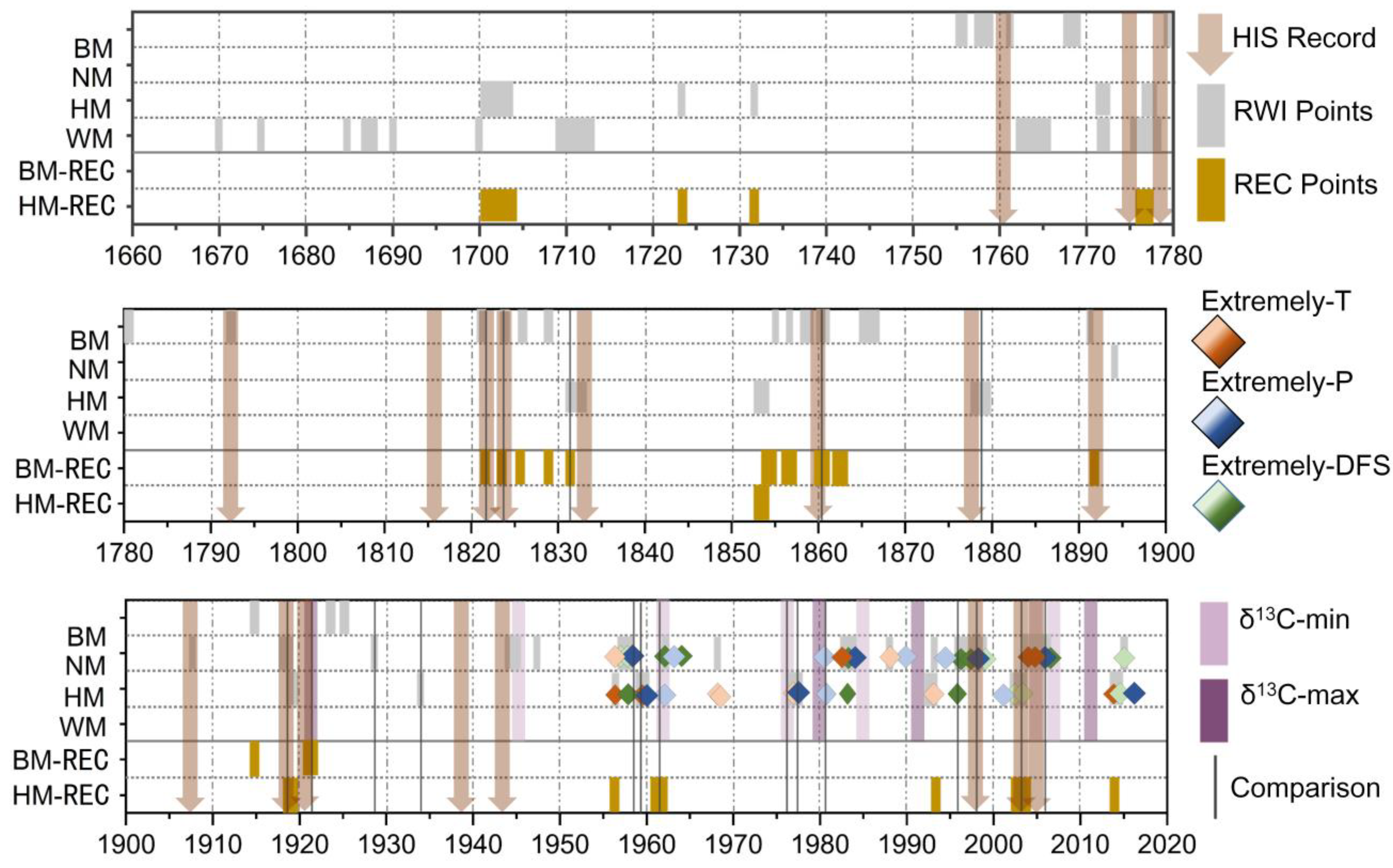
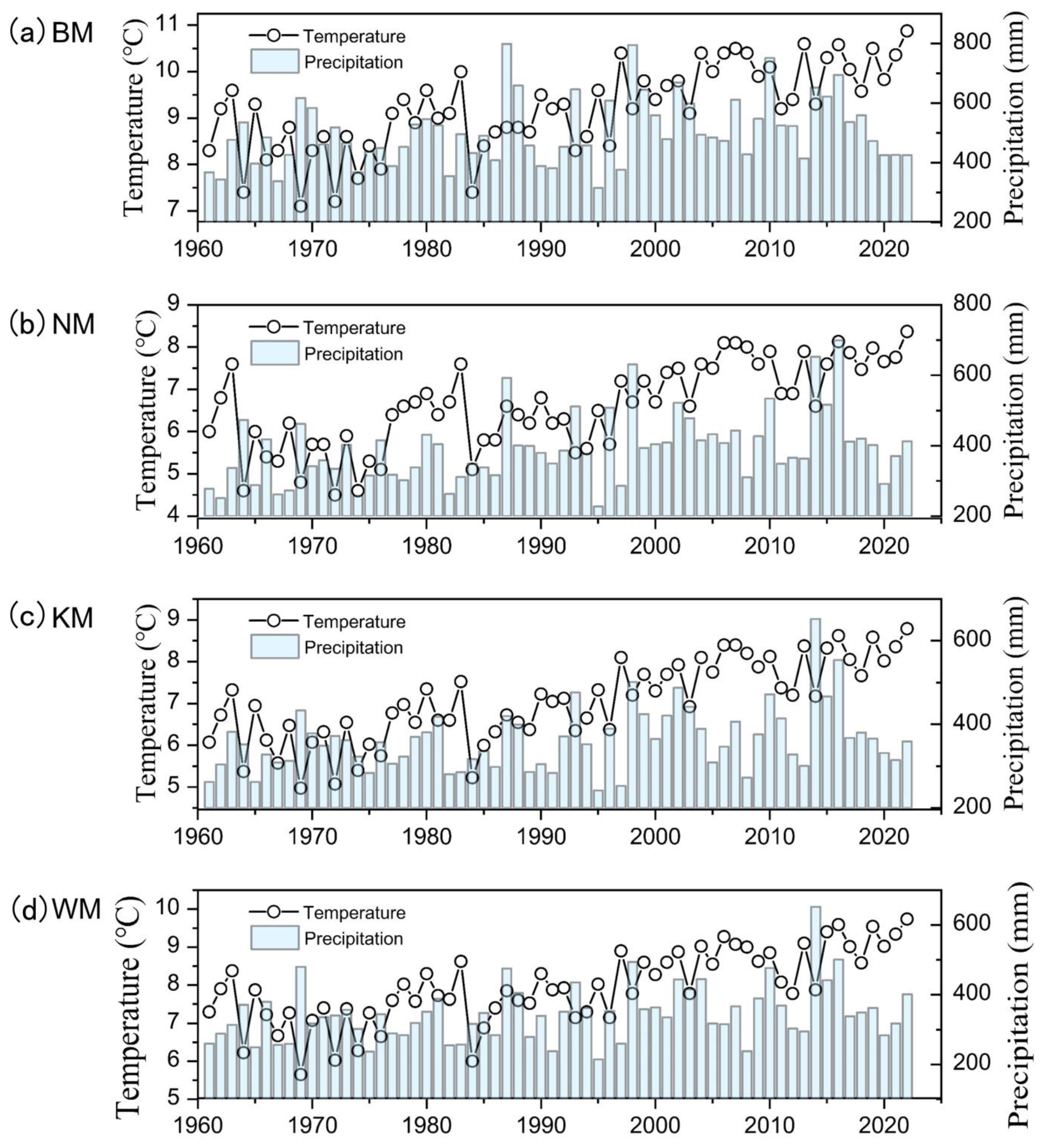
| Site | Longitude (°N) | Latitude (°E) | Date | Elevation (m asl) | Aspect | Slope (°) | Canopy Density | NOtrees | NOsamples |
|---|---|---|---|---|---|---|---|---|---|
| AH1 | 42°34′34.24″ | 81°11′47.15″ | September 2016 | 2266 | N | 10 | 0.5 | 12 | 25 |
| AH2 | 42°41′26.65″ | 81°4′54.47″ | September 2016 | 1950 | NE | 35 | 0.5 | 18 | 36 |
| AH3 | 42°42′39.9″ | 81°03′21.2″ | August 2006 | 2685 | EN-W | 35 | 0.3 | 24 | 48 |
| AWL | 43°24′54.6″ | 81°04′35.7″ | August 2006 | 2739 | N-E | 45 | 0.1 | 25 | 90 |
| GS2 | 43°12′42.5″ | 84°47′7.27″ | September 2016 | 2355 | N | 0 | 0.2 | 18 | 36 |
| GS3 | 43°17′13.72″ | 84°18′47.16″ | September 2016 | 1698 | NW | 40 | 0.5 | 15 | 30 |
| GZ1 | 44°26′21.21″ | 81°4′15.68″ | September 2016 | 1542 | NW | 50 | 0.2 | 5 | 9 |
| GZ2 | 44°28′27.19″ | 81°9′31.58″ | September 2016 | 2050 | N | 20 | 0.9 | 18 | 36 |
| KD | 43°8′53.1″ | 82°53′57.7″ | September 2016 | 1813 | NE | 20 | 0.7 | 12 | 25 |
| KS1 | 43°42′23.29″ | 83°41′44.56″ | September 2016 | 1809 | NW | 0 | 0.1 | 18 | 35 |
| GS1 | 43°17′ | 84°18′ | June 2015 | 1770 | N | 30 | 0.1 | 24 | 46 |
| QES | 43°36′36.06″ | 84°19′33.82″ | September 2016 | 2370 | W | 10 | 0.4 | 18 | 36 |
| QX1 | 43°3′30.97″ | 82°44′33.8″ | September 2016 | 1894 | NE | 40 | 0.7 | 12 | 25 |
| QYZ | 43°27′04.5″ | 81°27′40.0″ | August 2006 | 2322 | EN-N | 70 | 0.4 | 25 | 50 |
| WS1 | 43°27′43.38″ | 81°7′16.84″ | September 2016 | 2150 | NE | 30 | 0.8 | 15 | 30 |
| WS2 | 43°25′40.17″ | 81°3′25.47″ | September 2016 | 2552 | NW | 10 | 0.6 | 18 | 36 |
| XT1 | 42°37′43.68″ | 80°36′20.44″ | September 2016 | 2049 | NW | 10 | 0.9 | 15 | 30 |
| XT2 | 42°37′27.22″ | 80°37′11.33″ | September 2016 | 2066 | NNE | 10 | 0.9 | 18 | 36 |
| Site ID | Site | Longitude | Latitude | Elevation | Time | Data Type |
|---|---|---|---|---|---|---|
| 51328 | HRGS | 44.23 | 80.48 | 713.3 | 1959–2016 | Temperature extreme (°C), precipitation extreme (mm), daily minimum temperature consecutive days (days), ground temperature extreme (°C), maximum frozen soil depth (mm), etc. |
| 51329 | HC | 44.04 | 80.84 | 624.3 | 1959–2016 | |
| 51430 | CBCR | 43.83 | 81.15 | 602.6 | 1959–2016 | |
| 51431 | YN | 43.95 | 81.33 | 662.5 | 1951–2016 | |
| 51433 | NLK | 43.8 | 82.56 | 1105.2 | 1958–2016 | |
| 51434 | YNX | 43.96 | 81.53 | 770 | 1960–2016 | |
| 51435 | GL | 43.46 | 82.23 | 774.9 | 1960–2016 | |
| 51436 | XY | 43.45 | 83.3 | 928.2 | 1955–2016 | |
| 51437 | ZS | 43.15 | 81.13 | 1851 | 1954–2016 | |
| 51438 | TKS | 43.18 | 81.76 | 1239.6 | 1959–2016 |
| Location | Site | Ncores | Rbar-t | Rbar-e | EPS | SNR | Chronology Interval |
|---|---|---|---|---|---|---|---|
| BM | KS1, QES, GS3, NLD, GS2, | 143 | 0.466 | 0.466 | 0.966 | 28.555 | 1815–2016 |
| NM | QX1, KD | 51 | 0.369 | 0.269 | 0.944 | 16.912 | 1737–2016 |
| KM | XT1, XT2, AH1, AH2, AH3, | 160 | 0.646 | 0.346 | 0.965 | 27.384 | 1657–2016 |
| WM | WS1, WS2, AWL, QYZ | 156 | 0.377 | 0.277 | 0.979 | 45.721 | 1657–2016 |
| Location | BRNN | MLR | RF | |||||||||||||||
|---|---|---|---|---|---|---|---|---|---|---|---|---|---|---|---|---|---|---|
| r | RMSE | RRSE | d | RE | CE | r | RMSE | RRSE | d | RE | CE | r | RMSE | RRSE | d | RE | CE | |
| BM | 0.79 | 0.68 | 0.82 | 0.65 | 0.56 | 0.56 | 0.80 | 0.82 | 0.76 | 0.67 | 0.32 | 0.32 | 0.76 | 0.57 | 0.66 | 0.82 | 0.38 | 0.38 |
| NM | 0.65 | 0.80 | 0.92 | 0.77 | 0.49 | 0.42 | 0.62 | 6.45 | 0.94 | 0.71 | 0.37 | 0.28 | 0.72 | 5.64 | 0.77 | 0.81 | 0.51 | 0.45 |
| KM | 0.85 | 0.75 | 0.71 | 0.86 | 0.49 | 0.48 | 0.88 | 2.94 | 0.52 | 0.93 | 0.73 | 0.73 | 0.85 | 3.53 | 0.62 | 0.92 | 0.62 | 0.61 |
Disclaimer/Publisher’s Note: The statements, opinions and data contained in all publications are solely those of the individual author(s) and contributor(s) and not of MDPI and/or the editor(s). MDPI and/or the editor(s) disclaim responsibility for any injury to people or property resulting from any ideas, methods, instructions or products referred to in the content. |
© 2023 by the authors. Licensee MDPI, Basel, Switzerland. This article is an open access article distributed under the terms and conditions of the Creative Commons Attribution (CC BY) license (https://creativecommons.org/licenses/by/4.0/).
Share and Cite
Fan, Y.; Li, Q.; Shang, H.; Jiang, S.; Zhang, T.; Zhang, R.; Qin, L.; Yu, S.; Zhang, H. Snowpack Dynamics Influence Tree Growth and Signals in Tree Rings of Tianshan Mountain, Central Asia. Remote Sens. 2023, 15, 2849. https://doi.org/10.3390/rs15112849
Fan Y, Li Q, Shang H, Jiang S, Zhang T, Zhang R, Qin L, Yu S, Zhang H. Snowpack Dynamics Influence Tree Growth and Signals in Tree Rings of Tianshan Mountain, Central Asia. Remote Sensing. 2023; 15(11):2849. https://doi.org/10.3390/rs15112849
Chicago/Turabian StyleFan, Yuting, Qian Li, Huaming Shang, Shengxia Jiang, Tongwen Zhang, Ruibo Zhang, Li Qin, Shulong Yu, and Heli Zhang. 2023. "Snowpack Dynamics Influence Tree Growth and Signals in Tree Rings of Tianshan Mountain, Central Asia" Remote Sensing 15, no. 11: 2849. https://doi.org/10.3390/rs15112849
APA StyleFan, Y., Li, Q., Shang, H., Jiang, S., Zhang, T., Zhang, R., Qin, L., Yu, S., & Zhang, H. (2023). Snowpack Dynamics Influence Tree Growth and Signals in Tree Rings of Tianshan Mountain, Central Asia. Remote Sensing, 15(11), 2849. https://doi.org/10.3390/rs15112849





